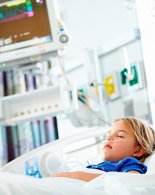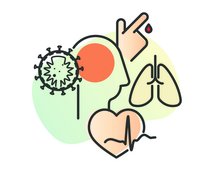Projects
Projects in the Cardiac Arrest Network

Socioeconomic factors may influence outcomes through multiple mechanisms including difference in co-morbidities and differential treatments including less aggressive care.
However, little is known about the impact of socioeconomic factors in patients with in-hospital cardiac arrest both in Denmark and internationally. We wish to assess the relationship between socioeconomic factors and treatments and outcomes for patients with in-hospital cardiac arrest in Denmark. Identifying such relationships will facilitate interventions to improve equality in treatment and outcomes.
Read more about the project
The Use of Telemetry following Acute Myocardial Infarction

The aim of this project is to determine whether there is a difference in return of spontaneous circulation (ROSC) depending on the type of vascular access (intravenous or intraosseous) placed during out-of-hospital cardiac arrest (OHCA).
Read more about this project
Handover of information from ward staff to the cardiac arrest team during in-hospital cardiac arrest: Identifying deficiencies and building a new model
This study aims to investigate barriers and facilitators for handover of patient information from ward staff to the cardiac arrest team during in-hospital cardiac arrest (IHCA) and develop a tool for structured handover.
Projects in the CONSIDER Sepsis Network
Projects in the Design-EM Network
The projects aims at investigating how healthcare professionals use an information system (IS) to support patient treatment in a shift work context. Theoretically, use is motivated by a number of factors related to the individual user’s domain such as usefulness to the individual user’s work or ease of use. In a setting in which close collaboration not only within a single work shift, but also across is a prerequisite for the quality of patient care/outcome, the use of IS may be motivated by other factors than usefulness and ease of use.
Read more about the project
The Covid-19 pandemic has affected healthcare systems and patient safety worldwide; however, with different implications for societies, health, and survival. So far, published research on organizational changes and their possible clinical consequences during Covid-19 is sparse. To be well prepared for a new pandemic or future crises affecting healthcare, it is crucial to evaluate the efforts and learning embedded in handling the pandemic
The aim of the project is to analyze the organizational steps at various levels in two acute healthcare systems (Denmark and Italy) and further analyze the clinical consequences on flow and patient safety.
Treatment of elderly patients in own home – a cross-sectorial alternative to emergency admission
The purpose of this research project is to avoid cases with unnecessary emergency admissions of elderly, medical patients to reduce the risk of infections, delirium and physical and psychical loss of function at a vulnerable patient group.
Projects in the International Network
Projects in Patient Safety Network

The overall aim is this project is to improve the performance of PEWS and its acceptability among healthcare professionals. Three studies including a scoping review, a Delphi study and a prospective, cluster-randomized cross-over project will be conducted. The project will contribute to the existing knowledge of PEWS and nurses’ clinical judgment in relation to clinical deterioration of children.

The project investigates ambulatory care sensitive conditions (ACSCs) among patients with multimorbidity. The project uncovers patient-related and organisational characteristics of admissions to hospital emergency departments. The aim is to develop and test risk assessment tool for use in primary care in order to prevent certain acute admissions effectively.
Projects in Point-of-Care Ultrasound Network

The primary aim of the study is to determine the effect of a point-of-care ultrasound-driven diagnostic pathway in dyspneic ED patients on 24-hour hospital stay when compared to standard diagnostic pathway

The aim of this project is to develop a blended teaching program with spaced simulation training compared to traditional instructor-led classroom teaching. This study will contribute with important knowledge on how to optimally acquire competence in ultrasound guided thoracentesis at both a national and international level. The results of this project will help set standards for future evidence-based training as no guidelines exist for training in thoracentesis.
Projects in Trauma Network
From Trauma to Stroke: Blunt Cerebrovascular Injuries in Denmark (FTS-BCVI)

The overall purpose of the project is to describe and characterize the evolution of trauma epidemiology and mechanisms over the past 20 years in a representative region of Denmark.
The focus will be concerned trauma types, severity, epidemiological parameters, uptake area and vital parameters upon arrival at the Aarhus University Hospital Trauma Center.
From Trauma to Stroke: Blunt Cerebrovascular Injuries in Denmark (FTS-BCVI)
Title
From Trauma to Stroke: Blunt Cerebrovascular Injuries in Denmark (FTS-BCVI)
Aim of the Study
New knowledge about the Danish blunt cerebrovascular injury (BCVI) patients can identify areas for improvement within screening, diagnostics, and treatment, potentially leading to the establishment of a standardized national care. Therefore, the aims of the study are to investigate incidence and describe the patient cohort and investigate treatment, stroke rate and mortality.
Study Design
The study is a national retrospective descriptive cohort study which takes place at Aarhus University hospital in the central region of Denmark and will be executed from February 2024 to February 2025.
Methods
Utilizing the Danish Patient Registry we seek to identify all the Danish BCVI-patients in the period of 2010-2019, by usage of ICD-10 codes describing affection of the greater vessels in the neck. Following patient identification, the medical records will be examined to identify the presence of a relevant trauma, and if present the patient is included. The BCVI cohort will then be described in terms of demographics, vitals at arrival, exposure to trauma, treatment, and patient outcomes.
Setting
National study including all Danish BCVI-patients from the five regions in the period of 2010-2019.
Perspectives
The majority patients suffering from BCVI, according to international literature, are young adults, who must live the rest of their expected lifetime with the consequences from a BCVI-induced stroke. Enhanced understanding of BCVI-patients can hopefully yield guidelines, expedite treatment, and ultimately save more patients from BCVI-induced stroke.
Conflicts of interest
None.
Research Group
Research Center of Emergency Medicine, Aarhus University Hospital
Emergency Department, Aarhus University Hospital
Philip Uhd, Bsc. Med, Research Year Student and Medical Student
Nikolaj Raaber, ass. Professor, MD, PhD
Bas De Groot, Professor, MD, PhD
Niels Hjort, ass. Professor, MD, PhD
Marianne Lisby, ass. Professor, PhD, MHSc, RN
Other Projects

The aim of the study is to improve acute pain treatment in the ED, for both opioid tolerant and opioid naïve patients. KeTMo is a randomized, double-blinded trial, investigating the combination of IV LDK and IV morphine versus IV morphine and placebo as regards to analgesic. This study is the first to examine the effect of LDK as an adjunct to morphine in a general patient population in the ED with a prior use of opioids and to compare it with the effect for patients without a prior use of opioids.